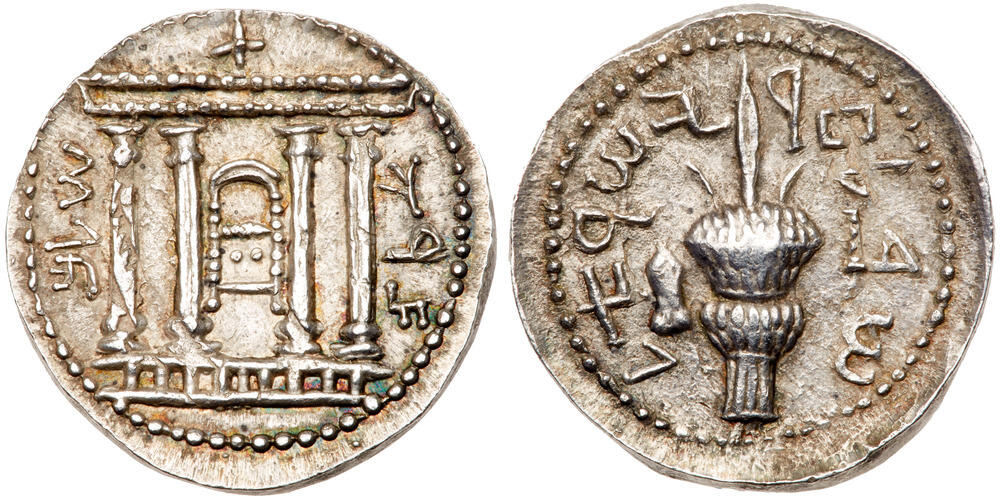Judaea (uncertain mint) (Bar Kokhba), silver, tetradrachms (132-135 CE)
From SILVER
132 CE - 135 CE Silver 6,899 kg
Description
| ObverseInscription or printing placed on the obverse.: | 'Simon' (Paleo-Hebrew).Tetrastyle façade of the Temple of Jerusalem, show bread table or Ark of the Covenant in chest form with semicircular lid and short legs, seen from a narrow side, above façade, cross. |
| ReverseInscription or printing placed on the reverse.: | 'Year two of the freedom of Israel' (Paleo-Hebrew).lulav with etrog at left |
Mint and issuing power
| MintIdentifies the place of manufacture or issue of a numismatic object.: | Judaea (uncertain mint) | Ancient regionAncient region.: | Judaea | Modern countryModern country: Israel | AuthorityIdentifies the issuing power. The authority can be "pretended" when the name or the portrait of X is on the coin but he/she was not the issuing power. It can also be "uncertain" when there is no mention of X on the coin but he/she was the issuing power according to the historical sources: | Simon bar Kokhba (military leader and king of Judea, 132-135 CE) |
Chronology
| FromIdentifies the initial date in a range assigned in a numismatic context. | 132 CE | toIdentifies the final date in a range assigned in a numismatic context.. | 135 CE | PeriodTime period of the numismatic object.: Roman from 30 BC |
Physical description
| MetalThe physical material (usually metal) from which an object is made.: | Silver |
Median weightMedian of the weights of numismatic objects (in grams). in grams | 14.50 | DenominationTerm indicating the value of a numismatic object. Examples: tetradrachm, chalkous, denarius.: | tetradrachm, sela | StandardStandard.: |
Image

Bar Kokhba tetradrachms.jpg [1]
References
| Die study referencePublication of the study: | Mildenberg 19841Mildenberg 1984, p. 123-172 | ||
| Coin series referenceReference to coin series study: | |||
Obverse dies distribution
| FrequencyFrequency of specimen in distribution. ᵖ | Number of obversesNumber of obverse dies. ᵖ (o) | % (o) | Number of coinsNumber of coins. (n) | % (n) | Die nameName(s) of the die(s). |
| 1 | 6 | 24 | 6 | 7, 18, 19, 20, 24, 25 | |
| 2 | 2 | 8 | 4 | 21, 22 | |
| 5 | 1 | 4 | 5 | 9 | |
| 7 | 1 | 4 | 7 | 16 | |
| 12 | 1 | 4 | 12 | 23 | |
| 16 | 1 | 4 | 16 | 10 | |
| 21 | 1 | 4 | 21 | 5 | |
| 24 | 1 | 4 | 24 | 3 | |
| 30 | 1 | 4 | 30 | 2 | |
| 34 | 1 | 4 | 34 | 15 | |
| 48 | 1 | 4 | 48 | 6 | |
| 55 | 1 | 4 | 55 | 11 | |
| 60 | 1 | 4 | 60 | 1 | |
| 65 | 1 | 4 | 65 | 8 | |
| 77 | 1 | 4 | 77 | 4 | |
| 126 | 1 | 4 | 126 | 13 | |
| 133 | 1 | 4 | 133 | 14 | |
| 150 | 1 | 4 | 150 | 17 | |
| 290 | 1 | 4 | 290 | 12 | |
| Total | 25 of 25 | 100 | 1163 of 1,163 |
Reverse dies distribution
no distribution is available
Quantification
| Number of obversesNumber of obverse dies. ᵖ (o) | 25 | Number of singletons (o1)The number of singleton coins. ᵖ | 6 |
| Number of reverse diesNumber of reverse dies. (r) | 78 | Number of coinsNumber of coins. (n) | 1163 |
| Coins per obverse dieNumber of coins per obverse die. (n/o) | 46.52 | Coins per reverse dieNumber of coins per reverse die. (n/r) | 14.91 |
| Reverse per obverse ratioRatio of obverse dies divided by reverse dies. (r/o) | 3.12 | Percentage of singletons (o1)number of coins (n) divided by the number of singletons (o1) ᵖ | 24 % |
| Original number of dies (O) (Carter 1983 formula)The estimation of the number of coins according to Carter 1983 ᵖ | 23.79 | Coins struck if 20,000 as average productivity per dieCoins made if the average productivity for obverses (according to Carter) is 20,000. ᵖ | 475,800 |
| Original number of dies (O) (Esty 2011 formula)The estimation of the number of coins according to the singleton formula in Esty 2011 ᵖ (O) | 25.55 | Survival rate if 20,000 as average productivity per dieSurvival rate if average productivity is 20,000. ᵖ | 0.00244 |
| Coverage (o = % of O) (Esty 1984 formula)Esty 1984 - coverage (% of O) ᵖ (o = % of O) | 99.48% | Die productivity if survival rate 1/2,000Average productivity if survival rate is 1/2,000. ᵖ | 97,772.17 |
| Weight of silver (in kg) if 20,000 coins per die (O = Carter formula)Carter 1983 * Median weight * 20000 (*10 if gold or electrum) ᵖ | 6,899 kg <br /> 6,899 kg | Die productivity if survival rate 1/5,000Average productivity if survival rate is 1/5,000. ᵖ | 244,430.43 |
Remarks
Most likely one single workstation Certainly military
References
- ^ Mildenberg, Leo (1984), The Coinage of the Bar Kokhba War, Typos VI, Aarau, Verlag Sauerländer, 396 p.